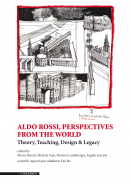Although architecture was historically considered the most public of the arts and the interdependence between building and the public realm was a key feature of the post-war discourse, the process of postmodernization undermined some of the traditional structures of power through which architecture operated. At the center of this shakeup was the modern structure par excellence: the State.
This book analyzes the dissolution of the bond between architecture and the State through a double lens. First, this study is framed by the workings of an architect, Aldo Rossi, whose practice mirrored this transformation in a unique way, going from Mussolini’s Italy to Reagan’s America, from the Communist Party to Disneyland. The second lens is provided by a set of technological apparatuses that, in this pre-digital world, impacted the reach of the State and the boundaries of architecture. Drawing on the multifaceted root of the term “State,” this book sets out to explore a series of case studies that addressed the need to re-state architecture – both in the sense of relocating architecture within new structures of power and in the sense of finding ways to keep reproducing it in those uncharted territories.
Sebbene l’architettura sia stata sempre considerata la più pubblica delle arti e l’attenzione per la sfera pubblica sia stata una delle linee guida del discorso architettonico nel secondo dopoguerra, il processo di postmodernizzazione ha messo in discussione diverse strutture di potere attraverso le quali l’architettura era solita operare. Al centro di questa trasformazione troviamo una delle strutture cardine della modernità: lo Stato.
Questo libro analizza la dissoluzione del rapporto tra Stato e architettura attraverso una doppia lente. Il filo conduttore è l’attività di un architetto, Aldo Rossi, il cui percorso ha riflesso tali cambiamenti in modo unico, oscillando tra l’Italia di Mussolini e l’America di Reagan, tra il Partito Comunista e Disneyland. La seconda lente è legata ad un set di apparati tecnologici che, in un mondo non ancora digitalizzato, hanno contribuito ad alterare il raggio d’azione dello Stato e i confini dell’architettura. Facendo leva sulla radice sfaccettata del termine “Stato”, il libro mira ad esplorare una serie di casi di studio che hanno messo in luce la necessità di ridefinire lo stato dell’architettura – sia nel senso di riposizionare l’architettura all’interno di nuove strutture di potere che nel senso di trovare modi per continuare a riprodurla in acque inesplorate.





